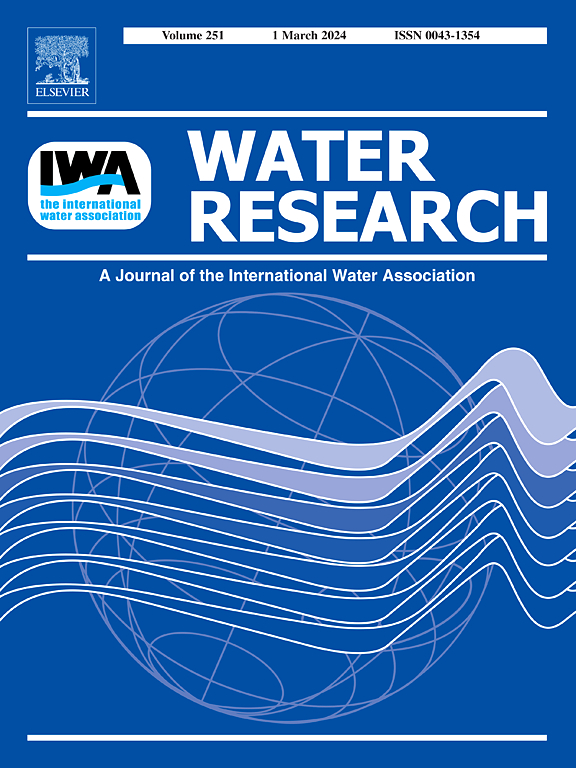接枝氧化石墨烯改性磷石膏对废水中重金属和染料的吸附和去除
IF 12.4
1区 环境科学与生态学
Q1 ENGINEERING, ENVIRONMENTAL
引用次数: 0
摘要
本研究利用氧化石墨烯(GO)和聚乙烯亚胺(PEI)的大表面积和较强的金属螯合能力,将其作为有机改性剂,对惰性磷石膏(PG)进行功能化,制备PG@GO@PEI吸附剂,有效去除废水中的重金属和染料。该吸附剂的制备是通过氧化石墨烯功能化PG,接枝PEI。通过傅里叶变换红外光谱(FTIR)、扫描电子显微镜(SEM)和粉末x射线衍射(PXRD)等多种方法对改变后的材料进行了表征,以证实接枝成功和表面性能的改善。制备的PG@GO@PEI吸附剂对重金属和染料具有优异的吸附性能,去除率接近100%。对Cr (VI)的最大吸附量为313.5 mg·g−1,对萘酚绿B (NGB)和孔雀石绿(mg)的最大吸附量分别为425.5 mg·g−1和3300.9 mg·g−1。XPS分析表明,Cr(VI)的吸附过程包括静电相互作用、离子交换和螯合作用,而NGB和MG的吸附过程包括静电相互作用、π-π相互作用和氢键相互作用。结果表明,pei接枝的氧化石墨烯改性显著提高了PG的吸附能力。此外,使用GAPI、Complex GAPI、AGREE和AGREEprep指标工具进行的评估表明,所建立的方法具有绿色度和环境可持续性。本研究开辟了废弃PG资源化利用的新途径,缓解了PG长期储存造成的环境污染问题。本研究也证明了PG@GO@PEI作为一种可持续有效的废水处理吸附剂的潜力,有助于绿色环境修复技术的发展。本文章由计算机程序翻译,如有差异,请以英文原文为准。


PEI-grafted graphene oxide modified phosphogypsum for the adsorption and removal of heavy metals and dyes in wastewater
In this study, due to its large surface area and strong metal chelation ability, graphene oxide (GO) and polyethyleneimine (PEI) are used as organic modifiers to functionalize inert phosphogypsum (PG) to prepare PG@GO@PEI adsorbent for effective removal of heavy metals and dyes from wastewater. The preparation of the adsorbent involved functionalizing PG with GO, followed by grafting PEI. The altered material was characterized through several methods, such as Fourier-transform infrared spectroscopy (FTIR), Scanning electron microscopy (SEM) and Patterns of powder X-ray diffraction (PXRD), to confirm successful grafting and improved surface properties. The prepared PG@GO@PEI adsorbent exhibits excellent adsorption performance for heavy metals and dyes, with removal rates close to 100 %. The maximum adsorption capacity for Cr (VI) is 313.5 mg·g−1, whereas the maximum adsorption capacities for naphthol green B (NGB) and malachite green (MG) are 425.5 mg·g−1 and 3300.9 mg·g−1, respectively. XPS analysis revealed that Cr(VI) adsorption involved electrostatic interaction, ion exchange and chelation, while for NGB and MG adsorption, it could include electrostatic interaction, π-π interaction, and hydrogen bonding interaction. The results demonstrated that the PEI-grafted GO modification markedly improved the adsorption capacity of PG. Furthermore, an assessment using the GAPI, Complex GAPI, AGREE, and AGREEprep metrics tools demonstrates greenness of the established method and environmental sustainability. This study develop the new approach for waste PG resource utilization, alleviating the problem of environmental pollution caused by long-time storage of PG. This study also demonstrates the potential of PG@GO@PEI as a sustainable and effective adsorbent for wastewater treatment, contributing to the development of green technologies for environmental remediation.
求助全文
通过发布文献求助,成功后即可免费获取论文全文。
去求助
来源期刊

Water Research
环境科学-工程:环境
CiteScore
20.80
自引率
9.40%
发文量
1307
审稿时长
38 days
期刊介绍:
Water Research, along with its open access companion journal Water Research X, serves as a platform for publishing original research papers covering various aspects of the science and technology related to the anthropogenic water cycle, water quality, and its management worldwide. The audience targeted by the journal comprises biologists, chemical engineers, chemists, civil engineers, environmental engineers, limnologists, and microbiologists. The scope of the journal include:
•Treatment processes for water and wastewaters (municipal, agricultural, industrial, and on-site treatment), including resource recovery and residuals management;
•Urban hydrology including sewer systems, stormwater management, and green infrastructure;
•Drinking water treatment and distribution;
•Potable and non-potable water reuse;
•Sanitation, public health, and risk assessment;
•Anaerobic digestion, solid and hazardous waste management, including source characterization and the effects and control of leachates and gaseous emissions;
•Contaminants (chemical, microbial, anthropogenic particles such as nanoparticles or microplastics) and related water quality sensing, monitoring, fate, and assessment;
•Anthropogenic impacts on inland, tidal, coastal and urban waters, focusing on surface and ground waters, and point and non-point sources of pollution;
•Environmental restoration, linked to surface water, groundwater and groundwater remediation;
•Analysis of the interfaces between sediments and water, and between water and atmosphere, focusing specifically on anthropogenic impacts;
•Mathematical modelling, systems analysis, machine learning, and beneficial use of big data related to the anthropogenic water cycle;
•Socio-economic, policy, and regulations studies.
 求助内容:
求助内容: 应助结果提醒方式:
应助结果提醒方式:


